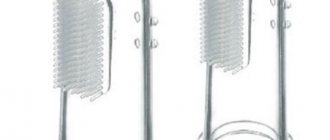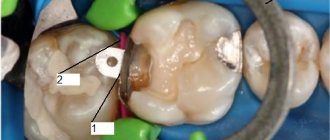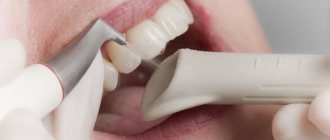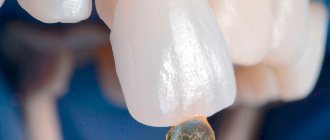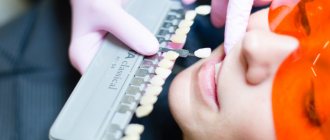Author of the article:
Soldatova Lyudmila Nikolaevna
Candidate of Medical Sciences, Professor of the Department of Clinical Dentistry of the St. Petersburg Medical and Social Institute, Chief Physician of the Alfa-Dent Dental Clinic, St. Petersburg
Cigarette plaque on teeth is an extremely unpleasant consequence of active smoking. It gradually accumulates on the enamel, causing its color to change.
When you abuse tobacco, your smile takes on a pronounced yellow or even dark brown tint, and unsightly stains appear on your teeth that cannot be removed with a brush.
The change in enamel color is a consequence of exposure to substances that are part of smoke, such as nicotine, phenolic and ammonia compounds, and tar. All of them firmly settle on the porous surface of the teeth, penetrating deeper and deeper over time, which leads to the fact that the yellowness becomes more and more pronounced.
The worse a smoker cares about oral health, the faster plaque forms, which ultimately leads not only to aesthetic problems, but also to deterioration in the quality of enamel.
If measures are not taken in a timely manner, the yellow plaque turns into gray-brown. This leads to inflammation of the gums and impaired blood circulation in them. Bleeding, periodontal disease, caries and tartar may occur. Further, the smoker may experience tooth loss, so it is worth paying attention and addressing the problem in a timely manner.
How cigarettes affect teeth
The main symptoms of oral disease that appear in smokers can be identified:
- gums become pale pink;
- periodontal tissues are not inflamed;
- the cervical surfaces of the teeth are covered with a dark brown coating;
- Possible bad breath.
Types of cigarette plaque
Plaque caused by smoking varies in color:
- White plaque forms throughout the day or at night. This is a soft plaque, the appearance of which is also promoted by eating food. It is not dangerous to health and can be easily eliminated with thorough brushing of your teeth.
- Green plaque is a consequence of deformation of the pellicle or exposure to a chromogenic fungus.
- Yellow and brown plaque is evidence of addiction to cigarettes, strong coffee or tea. It is formed due to exposure to pigments contained in smoke or products. Only dentists can completely remove stains or remove plaque from cigarettes on teeth. Professional cleaning and bleaching will be required.
- Black plaque. Teeth turn black from cigarettes if the development of processes that lead to yellow and gray plaque has not been stopped.
The effect of smoking on dental health
In the production of cigarettes, nicotine, tar, and chemical components are used, which settle in the micropores of the teeth, clog them and gradually change their shade from white to yellow and brown. The more a person smokes, the worse their teeth look. Nicotine and other substances in cigarettes disrupt blood circulation in the oral cavity and create favorable conditions for the proliferation of pathogenic microorganisms. Long-term smoking greatly weakens local immunity, thereby contributing to the development of not only caries, but also gingivitis, stomatitis and diseases of the ENT organs.
First, a yellow coating appears on a smoker’s teeth, mainly near the necks of the teeth, where stone most often forms.
Over time, brown plaque forms on teeth. They contain a large number of cariogenic microorganisms that produce acid and destroy tooth enamel.
This is why plaque on teeth after smoking cannot be ignored. If you cannot get rid of it at home, you need to seek help from a dentist. Statistics speak volumes about the impact of smoking on oral health: 40% of smokers aged 60-65 years are forced to use dentures due to the absence of most of their teeth.
How to remove plaque on teeth from cigarettes at home
Home remedies won't completely get rid of cigarette residue, but they can help reduce its impact.
Regular teeth cleaning
Every smoker should understand that their teeth require more careful care. Brush your teeth at least twice a day, and preferably after every major meal. Give this process at least five minutes. There should be about 20 movements per tooth. Clean the outer side first, then move on to the chewing surface and the inner edge of the side teeth. Finally, clean your tongue and rinse your mouth. For hygiene, it is better to use specialized pastes and rinses; they will make the procedure more effective.
Home whitening with folk remedies
As bleaching agents, you can use soda, activated carbon and lemon, as well as hydrogen peroxide (Attention: peroxide should never be swallowed!). Simply apply the substance to the surface of the tooth. It is important to remember that such procedures can be performed no more than twice a week and it is necessary to take long breaks. Otherwise, you will damage the enamel, which will only lead to bigger problems. This type of whitening will not help completely remove stains from cigarettes, but it will make the color of your smile a couple of shades lighter.
Whitening with special means
There are many special products available for home removal of yellow stains from tooth enamel. These can be whitening strips or a professional gel, which is applied with a brush and requires the use of a protective mouthguard. Before you start using these products, you should consult your dentist.
Ways to get rid of plaque
Some smokers believe that it is impossible to get rid of the yellow tint of teeth. This is wrong. It is quite possible to whiten yellowed enamel, and you can even try to do it at home. However, if the case is advanced, and the plaque has turned from yellowish to brown or even black, then folk remedies are likely to be ineffective. A dentist will help you thoroughly clean your teeth from old pigmentation.
Home whitening methods
When choosing methods for getting rid of plaque, you need to understand that home procedures will take much more time than professional cleaning at the dentist.
To remove plaque at home, you can use the following methods:
- Using baking soda. The abrasive properties of this substance allow you to effectively remove plaque and polish tooth enamel. To achieve results, you can use baking soda in its pure form or add it to your usual toothpaste. You can use this method no more than twice a week.
- Lemon peel. Rubbing the surface of the teeth with the crust of this fruit helps lighten the enamel.
- Cleaning with activated carbon. Crushed charcoal is applied to the brush and the teeth are cleaned with gentle movements. The method is highly effective, however, the efforts made should be controlled to avoid damage to the enamel.
- Using tea tree oil. This product is distinguished by its safety and has an additional antibacterial effect. After cleansing your teeth with regular toothpaste, apply a few drops of oil to your brush and gently brush your teeth again. Then rinse your mouth with water and a few drops of lemon. After the procedure, you may feel a slight numbness.
- Hydrogen peroxide. A few drops of peroxide solution are applied to a cotton swab and wiped over the teeth. After this, you need to perform hygiene with toothpaste and then rinse your mouth thoroughly. Peroxide has a pronounced effect, but has an adverse effect on the enamel.
- Factory products. Effective is the use of various whitening gels applied to the teeth using a special tray. Lightening agents in the form of strips have a similar effect. When using these devices, you must be careful and strictly follow the instructions in the instructions.
In order to avoid plaque caused by a bad habit, you need to brush your teeth after every cigarette you smoke. Unfortunately, this opportunity does not always exist. Regular use of home whitening methods will help get rid of fresh plaque and prevent it from acquiring a dark shade.
Attention! In addition to the above methods, it would be useful to include solid vegetables and some types of fruits in your diet, which help clean and brighten your teeth. These include: strawberries, apples, lemons, celery and carrots.
Features of whitening with soda
When wondering how to remove plaque on teeth after smoking, many people opt for baking soda.
The method is really effective, although there are contraindications, such as:
- tendency to bleeding gums;
- increased sensitivity of enamel;
- enamel pathologies (fluorosis, hypoplasia);
- carious infections.
If the listed contraindications are absent, you can try this type of whitening. Procedure steps:
- Prepare soda in the form of a dry powder or a paste-like mixture with water. You will also need a toothbrush.
- Baking soda must be applied to the toothbrush (if using dry powder, the brush must be moistened with water).
- Brush your teeth, being careful and trying not to get it on the oral mucosa.
- Rinse your teeth thoroughly.
This method should not be used more than twice a week. Baking soda can be used not in its pure form, but added to regular toothpaste.
Professional teeth cleaning after smoking
Advanced forms of plaque on teeth are best left to the dentist. A professional approach to lightening enamel after smoking includes two types of procedures:
- Professional hygiene. The procedure is carried out using soft abrasive cleaning and ultrasonic methods. During the manipulation process, teeth are even removed from old plaque and tartar.
- Enamel whitening. This method is used when the natural color of the teeth is not satisfactory, and the patient wants to have a perfectly snow-white smile.
Sometimes combined methods are used, combining them with subsequent remineralization of tooth enamel.
How to remove cigarette plaque on teeth: clinical methods
There are several effective ways to completely remove plaque formed as a result of smoking.
The first option is professional cleaning. It can be carried out using an AirFlow device, which supplies a solution with crushed abrasives under pressure. You can also remove stones and plaque using ultrasound. In addition, plaque is removed manually using special instruments - scalers and curettes.
The second option is chemical bleaching. It is carried out after cleaning and is a purely cosmetic procedure, since it does not provide any benefits to dental health, but after a few sessions you can get a radiant white smile. Chemical whitening involves applying specialized gels based on hydrogen peroxide. The gel is applied for half an hour or more, in addition, its action can be activated by a laser or light from a halogen lamp (photobleaching).
After you have cleaned your teeth of plaque, you need to take good care of them. Ideally, quit smoking altogether or at least reduce the number of cigarettes. Remember to brush your teeth thoroughly and regularly, eat less coloring products, and use specialized toothpastes.
Effect of smoke
The resinous substances contained in tobacco smoke gradually settle on the surface of the enamel and cover it with a thin but very durable film of plaque. Even a small amount is enough for the development of pathogenic microorganisms. Their accumulation not only negatively affects the appearance, but also leads to the destruction of tooth tissue.
Also, smoke greatly dries out the oral mucosa due to its high temperature. As a result, a smaller amount of salivary fluid is produced, and it is known to have a powerful bactericidal effect. As a result, the risk of developing caries and other pathologies increases several times.
Harmful substances contained in tobacco negatively affect tissue regeneration, which slows down treatment and recovery after surgery. Even small wounds heal much more slowly, and the person feels severe discomfort.
Clinical trials
Clinical studies have proven that regular use of professional toothpaste ASEPTA COFFEE AND TOBACCO for a month improved the hydration of the mucous membrane by 3.3 times, the remineralizing efficiency increased by 3.9 times, at the same time, the cleansing effect has increasing dynamics and reaches 60 .5% at 4 weeks of use.
Sources:
- Report on determining/confirming the preventive properties of toothpaste “ASEPTA PLUS” COFFEE and TOBACCO Author: doctor-researcher A.A. Leontyev, head Department of Preventive Dentistry, Doctor of Medical Sciences, Professor S.B. Ulitovsky. First St. Petersburg State Medical University named after. acad. I.P. Pavlova, Department of Preventive Dentistry
- Report on determining/confirming the preventive properties of toothpaste “ASEPTA PLUS” GENTLE WHITENING” Author: doctor-researcher A.A. Leontyev, head Department of Preventive Dentistry, Doctor of Medical Sciences, Professor S.B. Ulitovsky First St. Petersburg State Medical University named after. acad. I.P. Pavlova, Department of Preventive Dentistry
- Clinical and laboratory assessment of the influence of domestic therapeutic and prophylactic toothpaste based on plant extracts on the condition of the oral cavity in patients with simple marginal gingivitis. Doctor of Medical Sciences, Professor Elovikova T.M.1, Candidate of Chemical Sciences, Associate Professor Ermishina E.Yu. 2, Doctor of Technical Sciences Associate Professor Belokonova N.A. 2 Department of Therapeutic Dentistry USMU1, Department of General Chemistry USMU2
- Report on the determination/confirmation of the preventive properties of personal oral hygiene products “ASEPTA PLUS” Remineralization doctor-researcher A.A. Leontyev, head Department of Preventive Dentistry, Doctor of Medical Sciences, Professor S.B. Ulitovsky First St. Petersburg State Medical University named after. acad. I.P. Pavlova, Department of Preventive Dentistry
- Clinical studies of antisensitive toothpaste “Asepta Sensitive” (A.A. Leontyev, O.V. Kalinina, S.B. Ulitovsky) A.A. LEONTIEV, dentist O.V. KALININA, dentist S.B. ULITOVSKY, Doctor of Medical Sciences, Prof. Department of Therapeutic Dentistry, St. Petersburg State Medical University named after. acad. I.P. Pavlova
- The role of anti-inflammatory rinse in the treatment of periodontal diseases (L.Yu. Orekhova, A.A. Leontyev, S.B. Ulitovsky) L.Yu. OREKHOVA, Doctor of Medical Sciences, Prof., Head of Department; A.A. LEONTIEV, dentist; S.B. ULITOVSKY, Doctor of Medical Sciences, Prof. Department of Therapeutic Dentistry of St. Petersburg State Medical University named after. acad. I. P. Pavlova
Smoking and tooth extraction
The question of how safe it is to smoke after tooth extraction worries many smokers. The procedure itself is associated with a certain amount of stress, and therefore many patients involuntarily have the urge to smoke a cigarette after visiting the dentist’s office. It is believed that this way you can get a certain calming effect. However, it is still better to refrain from this ritual, because nicotine and tar can have an irritating effect on an open wound. Otherwise, there is a risk of bleeding and pain. In addition, tobacco smoke slows down the healing process.
Important! After wisdom tooth removal, all precautions must be observed especially strictly. Often, such an operation is complicated by an overly branched and tangled root system, which the doctor is forced to remove in stages. If you smoke, be sure to tell your dentist this, and at the same time clarify how long after removal you can smoke a cigarette.
The patient will have to be patient and wait at least 2 hours after the procedure. It is important to wait until the bleeding stops completely. Another unpleasant consequence can be the so-called dry socket, while the presence of a protective blood clot in it is an extremely important condition for preventing wound infection.
Cleaning teeth from nicotine using professional methods
To make your teeth whiter, you can seek the help of professional dentists. After examining the tooth enamel, the doctor will be able to assess the severity of the situation and choose the appropriate method of cleaning from nicotine.
A very popular modern method is the use of ultrasound. It has a gentle effect on the enamel, helping to restore its natural whiteness. During the procedure, a beneficial effect is exerted on the oral mucosa. The ultrasonic method of cleaning teeth from nicotine is absolutely safe and has no contraindications.
Dentists often use special mouth guards that help cleanse teeth of nicotine. These plastic molds, made to fit the shape of the teeth, are filled with whitening solution and placed over the teeth. Gels, pastes, and solutions can be used as a bleaching agent. The best option is selected by the doctor after examining the oral cavity. This method does not immediately cleanse teeth of nicotine plaque. To achieve a visual effect, procedures should be carried out over 2-3 weeks, but the effect is very long-lasting.
Cleansing gels are applied directly to the teeth by rubbing into the enamel with a toothbrush. After hardening, the gel remains on the teeth until completely dissolved. The whitening effect appears after a month. This method is not recommended for those who have stomach problems, because the dissolved gel along with saliva can irritate the stomach mucosa.
Professional toothpastes can also be used to remove nicotine plaque. They contain abrasive particles that effectively clean the tooth surface. The results of using such pastes will not take long to arrive. This method is affordable, but its long-term use can negatively affect tooth enamel: its sensitivity will increase and its strength will be impaired.
General recommendations
To keep your teeth white and healthy, you not only need to whiten periodically, but also follow these rules:
- brush your teeth at least 2 times a day, thoroughly cleaning all surfaces of the teeth and spending at least 5 minutes on the procedure;
- use medicated paste constantly and periodically alternating it with a special whitening paste - we brush our teeth with a regular paste for 3 months and with a special whitening paste for 1 month;
- limit the consumption of strong tea, coffee, carbonated drinks and other products that stain tooth enamel;
- reduce consumption of foods containing high concentrations of sugar;
- give up smoking - only by completely giving up smoking can you achieve whiter teeth, otherwise you will have to carry out whitening constantly, and the result will get worse every year.
When can you smoke after teeth whitening?
Smoking after teeth whitening in the first days is strictly prohibited. Resins from tobacco smoke settle on the enamel, contributing to the rapid formation of a new dark plaque. In addition, smoke always burns the teeth, even if the smoker himself does not feel the burn. And if he smokes in the cold, then the temperature difference in the oral cavity leads to microcracks.
Smoking after bleaching is contraindicated for at least two weeks, and it is better to endure without cigarettes for a month. This will help not harm your teeth while they are hypersensitive and vulnerable. Before bleaching, you should also abstain from tobacco for two weeks. In order to preserve your whiteness, you should quit smoking for good.
It is not easy to take all the precautions, but the results are worth it. With careful oral care and constant avoidance of cigarettes and coloring products, a spectacularly white smile can last more than a year, and possibly more than two years. If, after the mandatory two weeks, you return to smoking and your previous eating habits, then within a few months the surface of your teeth will turn yellow.
Increased risk of cancer
In the process of smoking, toxic substances and carcinogens are released from tobacco. They lead to changes in the mucous membrane. Hot smoke irritates it, suppressing the production of lysozyme. This enzyme is responsible for disinfecting the oral cavity.
In smokers, the mucous membrane becomes dry over time. This increases susceptibility to injury and does not renew tissue. Because of this, the risk of developing cancer increases. According to studies, heavy smokers are 6 times more likely to have oral cancer.

